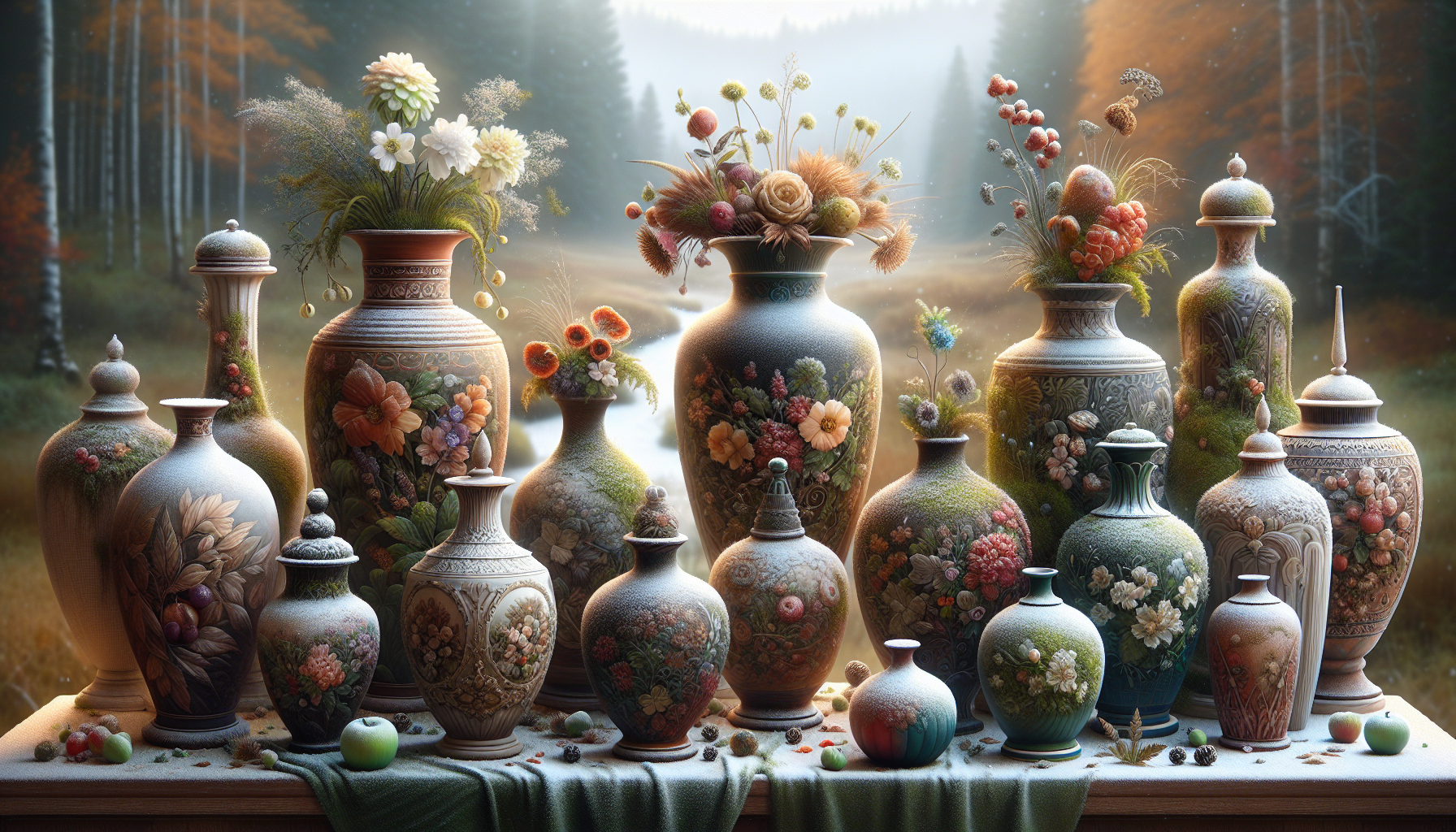In the world of archaeology, where every shard of pottery holds a whisper from the past, a unique tapestry is woven—a mosaic of colors, patterns, and histories that speak volumes about civilizations long gone. Pottery, often overlooked, serves as an incredible canvas upon which ancient cultures painted their stories. These artifacts, ranging from the simple to the intricately designed, offer us a direct link to understand societal norms, daily practices, and the aesthetic sensibilities of our ancestors. Today, we delve into a fascinating aspect of this ancient art form: the seasonal patterns found in pottery. These patterns not only reveal artistic preferences but also unveil the rhythms of life in different eras. The seasonal motifs provide clues about agricultural cycles, religious ceremonies, and even climatic conditions, painting a vivid picture of historical contexts that defined those times.
In exploring the beauty of pot patterns, we embark on a journey through time, examining how these designs evolved and what they signify about the cultures that created them. Why did certain patterns become prevalent during specific seasons? What do these motifs tell us about the environmental and social influences on these ancient societies? From the swirling motifs that mimic the movement of water to the geometric precision that echoes celestial alignments, each design tells a story of adaptation and expression. These patterns are more than mere decorations; they are records of human existence and the environment they lived in, offering insights into the cyclical nature of life and the interconnectedness of human and nature.
Throughout this article, we will uncover the stories behind some of the most intriguing pot patterns found across different civilizations. We will begin by exploring the origins and significance of seasonal motifs in pottery from ancient Mesopotamia, where the earliest forms of writing and artistic expression were born. Moving through time, we will examine the elegant pottery of ancient Greece, where mythological and natural themes dominated artistic expression, and how these designs reflect the changing seasons. We will also delve into the intricate patterns of Chinese ceramics, where each motif is imbued with symbolism and meaning, reflecting a deep connection to the natural world and seasonal transformations.
Join us as we reveal the hidden narratives etched into pottery, transcending mere artistry to offer a profound understanding of historical contexts. As we journey through these ancient lands, we will also discuss the modern implications of these discoveries and how they can inform contemporary art and cultural appreciation. By the end of this exploration, you will gain a new appreciation for the humble pot, a vessel of both utility and beauty, which continues to inspire and captivate us even today. Let us uncover the stories of the past and rediscover the timeless allure of seasonal pot patterns that have endured through centuries. 🏺✨
The Historical Significance of Pottery Patterns
Pottery has been an integral part of human civilization for thousands of years, serving both functional and decorative purposes. The patterns found on ancient pottery not only represent artistic expression but also provide valuable insights into the cultural and historical contexts of their time. These patterns, often rich with symbolism and meaning, reveal much about the societies that created them, including their beliefs, traditions, and interactions with the natural world.
Throughout history, pottery has served as a canvas for artisans to convey stories, religious beliefs, and cultural practices. The intricate designs found on pottery pieces can often be linked to the broader artistic movements of their time, reflecting influences from neighboring cultures and the unique characteristics of the civilizations that produced them. For instance, Greek pottery is renowned for its black-figure and red-figure techniques, which depict mythological scenes and daily life, offering a glimpse into ancient Greek society. Similarly, the elaborate motifs on Chinese porcelain tell tales of dynastic changes and evolving artistic styles over centuries.
Moreover, pottery patterns are significant for archaeologists and historians as they provide a chronological framework for dating and understanding ancient societies. By studying the evolution of pottery styles and techniques, researchers can trace the development of human civilization, identifying periods of technological advancement, trade relationships, and cultural exchange. Pottery patterns serve as a visual record, preserving the artistic and cultural achievements of past societies, and continue to inspire contemporary artists and designers today.
The Role of Seasons in Pottery Design
The changing seasons have long influenced human culture, and this is vividly reflected in pottery designs. Seasonal motifs not only add aesthetic value to pottery but also carry deeper cultural and symbolic meanings. By incorporating seasonal elements into their designs, potters celebrate the cycles of nature, express gratitude for the harvest, and convey messages of renewal and transformation.
In many cultures, the four seasons are associated with different deities, myths, and rituals, and these associations are often depicted in pottery patterns. For example, in ancient China, the seasons were linked to the Five Elements theory, with each season corresponding to a specific element and color. Spring, associated with the element of wood and the color green, was often represented by motifs of blooming flowers and new life. Summer, linked to the element of fire and the color red, featured images of the sun and vibrant flora. Autumn, with its connection to metal and the color white, was depicted through motifs of falling leaves and harvest scenes. Winter, associated with water and the color black, featured designs of snowflakes and barren trees.
This seasonal symbolism in pottery extends beyond decorative purposes, as it often played a role in religious and ceremonial practices. Pottery used in rituals might be adorned with specific patterns to honor deities or mark significant seasonal events, such as the solstices and equinoxes. The inclusion of seasonal motifs in pottery design thus served as a visual representation of the interconnectedness between humans and the natural world, reinforcing cultural beliefs and practices centered around the cycles of nature.
Comparative Analysis of Pottery Patterns Across Cultures
| Culture | Common Patterns | Symbolism |
|---|---|---|
| Greek | Geometric shapes, mythological scenes | Depiction of gods, heroes, and daily life |
| Chinese | Dragons, floral motifs | Power, prosperity, and harmony |
| Native American | Animals, nature symbols | Connection to nature, spiritual beliefs |
| Islamic | Geometric patterns, calligraphy | Unity, infinity, and divine order |
As shown in the table, Greek pottery is characterized by its geometric shapes and detailed mythological scenes, reflecting the Greeks’ fascination with gods and heroes. These patterns not only served as decoration but also communicated stories and cultural values. On the other hand, Chinese pottery often features dragons and floral motifs, symbols of power, prosperity, and harmony. These designs are deeply rooted in Chinese philosophy and cosmology, illustrating the cultural emphasis on balance and unity.
Native American pottery, with its animal and nature symbols, highlights the deep connection between indigenous peoples and the natural world. These patterns often have spiritual significance, representing the beliefs and traditions of Native American tribes. In contrast, Islamic pottery is renowned for its intricate geometric patterns and calligraphy, emphasizing the themes of unity, infinity, and divine order. The absence of figurative representations aligns with Islamic artistic principles, focusing instead on abstract designs that inspire contemplation and reflection.
Technological Advances and Modern Interpretations
The art of pottery has continually evolved, with technological advances playing a significant role in shaping its development. The introduction of new materials, techniques, and tools has expanded the possibilities for potters, allowing for greater creativity and precision in their designs. This section will explore how these advancements have influenced modern interpretations of traditional pottery patterns.
One of the most significant technological breakthroughs in pottery was the invention of the potter’s wheel, which revolutionized the production process by enabling faster and more uniform creation of pottery pieces. This innovation allowed artisans to experiment with more complex shapes and designs, leading to a flourishing of artistic expression. In addition, advancements in kiln technology have enabled potters to achieve higher firing temperatures, resulting in more durable and vibrant pottery.
In contemporary times, the use of digital technology has further expanded the possibilities for pottery design. Computer-aided design (CAD) software allows potters to create intricate patterns and simulate how they will appear on a finished piece. This technology enables artists to experiment with different designs and refine their work before even touching the clay. Moreover, 3D printing technology has opened up new avenues for creating pottery, allowing for the production of highly detailed and complex forms that were previously difficult to achieve by hand.
These technological advances have also influenced modern interpretations of traditional pottery patterns. Many contemporary potters draw inspiration from historical designs, reimagining them with a modern twist. This blending of old and new creates a dialogue between the past and present, celebrating the rich heritage of pottery while pushing the boundaries of artistic expression.
The Influence of Pottery Patterns on Contemporary Art and Design
The beauty and symbolism of traditional pottery patterns continue to inspire contemporary art and design. Artists and designers often draw from the rich visual language of pottery to create works that resonate with both historical significance and modern sensibilities. This section will explore how pottery patterns have influenced various artistic disciplines, from fashion to architecture.
In the fashion industry, designers frequently incorporate pottery-inspired motifs into their collections, using them as a source of inspiration for prints, textures, and color palettes. The intricate patterns found on pottery can be translated into fabric designs, creating garments that carry a sense of history and cultural richness. For example, the geometric patterns of Islamic pottery have inspired many fashion designers to create bold, eye-catching prints that celebrate the beauty of mathematical precision and symmetry.
Architecture is another field where pottery patterns have left a lasting impact. The use of ceramic tiles with intricate designs is a common feature in architectural projects, adding a touch of elegance and cultural depth to buildings. These tiles often draw inspiration from traditional pottery patterns, showcasing the timeless appeal of their designs. In particular, the use of decorative tiles in Islamic architecture, with their complex geometric patterns and vibrant colors, has influenced contemporary architects seeking to incorporate traditional elements into modern structures.
Pottery patterns also find their way into contemporary visual arts, where artists experiment with different mediums to reinterpret these timeless designs. Whether through painting, sculpture, or digital art, artists pay homage to the rich heritage of pottery while exploring new ways to express their creativity. This fusion of traditional and contemporary elements creates works that are both visually striking and culturally resonant.
- Explore the connections between pottery and modern design.
- Discover how traditional motifs inspire contemporary art.
- Learn about the influence of pottery patterns on various artistic disciplines.
As we continue to unearth the beauty of pot patterns and their seasonal records, it becomes clear that these designs hold more than just aesthetic value. They are a testament to human creativity, cultural exchange, and the enduring connection between past and present. Through the study and appreciation of pottery patterns, we gain a deeper understanding of the diverse cultural landscapes that have shaped our world.

Conclusion
**Conclusion: Unearthing the Beauty of Pot Patterns: Seasonal Records Revealed**
In delving into the intricate world of pottery, particularly through the lens of seasonal patterns, we uncover a story that is as rich and varied as the artifacts themselves. This exploration has led us on a journey through time, artistry, and the cultural narratives embedded in every curve and design of these earthen treasures. The primary aim of our discussion was to unearth the inherent beauty and historical significance of pot patterns, tracing their seasonal influences and the stories they tell about the societies that crafted them.
Initially, we explored the historical context of pottery, recognizing it as one of the earliest forms of human artistic expression and utilitarian design. The art of pottery, with its deep roots in ancient civilizations, serves not only as a utilitarian object but also as a cultural and artistic statement. Pottery patterns often reflect the environment and the resources available at the time of their creation, offering a window into the lives and climates of their creators. From ancient Mesopotamia to indigenous tribes across continents, pots have carried the imprints of different eras and peoples, mirroring their surroundings and seasonal changes.
The article then delved into the specific ways in which seasonal changes influence pottery designs. Seasonal patterns in pottery can include motifs that reflect the natural environment, such as plants, animals, and celestial bodies that are prominent during certain times of the year. These designs not only highlight the aesthetic aspects of pottery but also serve as a testament to the intimate relationship between humans and their environment. The cyclical nature of seasons has inspired countless generations of potters, each drawing from the unique palette of their local surroundings and experiences.
In our analysis, we also discussed the technical aspects of pottery, highlighting how different materials and firing techniques are influenced by the seasons. The availability of resources such as clay, as well as the conditions required for firing, are often dictated by the climate and time of year, affecting the final outcome of the pottery. This technical aspect underscores the adaptability and resourcefulness of ancient potters, who had to work with the limitations and opportunities presented by their environment.
Moreover, the article touched upon the cultural significance of seasonal pot patterns. These designs are more than mere decoration; they are expressions of cultural identity and heritage. Pottery has played a significant role in rituals, storytelling, and the preservation of cultural narratives. Each piece is a canvas that tells a story, encapsulating traditions, beliefs, and the way of life of the people who made them.
As we conclude, it is important to reinforce the beauty and relevance of studying pot patterns in the context of seasonal changes. This exploration not only enhances our appreciation for ancient art forms but also encourages us to reflect on the interconnectedness of nature, culture, and human creativity. In an increasingly globalized world, understanding and preserving such cultural artifacts allows us to celebrate diversity and appreciate the rich tapestry of human history.
We invite you, dear reader, to take these insights and apply them in your own explorations of art, culture, or history. Whether you’re an enthusiast, a scholar, or someone curious about the past, let this exploration inspire you to dig deeper and share your findings. Engage with us by leaving a comment below, sharing your thoughts and experiences with pottery or other cultural artifacts. Share this article with others who might find beauty and inspiration in these patterns, or who might have their own stories to tell.
The journey of discovery doesn’t end here. Continue exploring and appreciating the art and history that surrounds us. Each piece of pottery is a testament to the human spirit, creativity, and our enduring relationship with the world around us. Let us celebrate and preserve this heritage for future generations to enjoy and learn from.
🔗 [Explore more on pottery history here](https://www.ancient.eu/pottery/)
🔗 [Learn about traditional pottery techniques](https://www.ceramics.org/knowledge-center/traditional-ceramics)
Thank you for joining us on this journey through time and artistry. We hope it has inspired you to see the world, and its history, with new eyes. 🌍✨
Toni Santos is a visual storyteller and cognitive explorer whose work delves into the mental landscapes of ancient cultures—revealing how different civilizations perceived reality, memory, and meaning long before modern psychology existed. Through symbolic imagery and narrative inquiry, Toni brings to life the divergent ways of thinking that shaped lost worlds.
His creative path is guided by a fascination with non-linear logic, oral cosmologies, and the mythic frameworks that once guided decision-making, emotion, and identity. From memory temples carved in stone to visual languages encoded in textiles, every piece Toni creates reflects the vast cognitive diversity of the human story.
With a foundation in visual design and cultural semiotics, Toni blends analytical depth with artistic expression. His work goes beyond historical reconstruction—it reawakens the embodied, intuitive, and ritual-based intelligence of ancient minds, inviting us to question the assumptions of modern thought.
As the mind behind Vizovex, Toni curates visual studies, essays, and immersive content that explore forgotten epistemologies—ways of knowing that connected people to myth, land, and each other in profoundly different ways.
His work is a tribute to:
The symbolic intelligence of pre-modern cultures
The neural diversity embedded in ancient rituals and storytelling
The deep memory systems that shaped identity and perception
Whether you’re a researcher, an artist, or a seeker of hidden wisdom, Toni invites you to enter a space where cognition is culture, and where the past speaks through signs, cycles, and symbols—one myth, one memory, one mind at a time.





